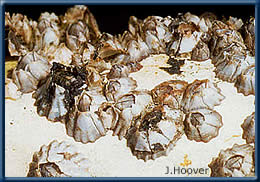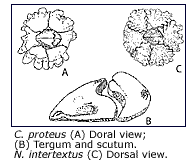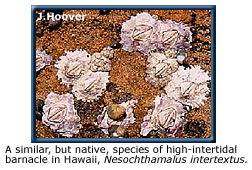

Balanus amphitrite

Balanus eburneus

Chthamalus proteus

Gonodactylaceus falcatus

Ligia exotica

Pachygrapsus fakaravensis

Scylla serrata
Chthamalus proteus
 Caribbean
barnacle
Caribbean
barnacle
Phylum Arthropoda
Subphylum Crustacea
Class Maxillopoda
Subclass Cirripedia
Order Thoracica
Family Chthamalidae
Description
Chthamalus proteus is a small light brown
or gray-white barnacle (to about 1 cm diameter). Its conical shell is
variable in external appearance depending on age, crowding, and degree
of weathering. Shell plates may be smooth or ribbed. The photo above is
of relatively uncrowded older individuals. Older weatherd individuals
of C. proteus superficially resemble Nesochthamalus
intertextus, a native intertidal species (pictured below). The
interleaving teeth between the shell plates differentiates N.
intertextus (see illustration below), and it tends to be dull purple.
 Habitat
Habitat
In the Hawaiian Islands, C. proteus inhabits
the high or supra-tidal zones of protected harbors and embayments, growing
on pilings and other surfaces. The native barnacle, N.
intertextus inhabits a similar zone, but only along exposed coasts.
C. proteus is commonly seen growing above
the water line on ships' hulls in Hawaii.
Distribution
Hawaiian Islands
Oahu - all South Shore harbors, and Kaneohe Bay
Kauai - Nawiliwili Harbor
Maui - Kahului Harbor
Hawaii - Hilo Harbor
Midway Atoll - main harbor
 Native
Range
Native
Range
Gulf of Mexico to Trinidad and north east Brazil
Present Distribution
Western Atlantic, Hawaiian Islands and Midway Atoll, and Guam.
Mechanism of Introduction
Unintentional, as fouling on ships' hulls.
Impact
Nuisance fouling organism. Ecological impact unstudied, but probably some
competition for space with native and nonindigenous invertebrates in the
high intertidal.
Ecology
Feeding
Barnacles have specialized paired appendages, called cirri, that they
use as a scoop net, reaching out into the water and extracting food particles.
When they cirri are drawn back, food is scraped off into the mouth.
 Reproduction
Reproduction
These barnacles are hermaphrodites, but cross-fertilization occurs in
dense populations. In such cases, males deposit sperm directly into the
mantle cavity of adjacent functional females via a long tube. Fertilized
eggs are brooded in the mantle cavity, and it may be several months before
the free-swimming planktonic larvae are released.
Remarks
This Caribbean barnacle probably appeared on Oahu sometime between 1973
and 1994. It was first observed on March, 1995 in Kaneohe Bay, but the
point of inoculation was most likely Pearl or Honolulu Harbor. When surveys
were undertaken in 1996, it was found to be widespread around Oahu, including
Pearl Harbor (Southward et al., 1998), and by 1996-1998 it had been found
on Kauai, Maui, Hawaii, Midway Island, and Guam. Southward et al. (1998)
noted that the date of introduction was after 1973 (the last thorough
barnacle surveys of Oahu) and it could have been as recently as 1994 or
1995. However, considering the present distribution of C.
proteus in the islands and the usual lag time between an introduction
and notable abundance, it was possibly earlier. Its abundance and widespread
distribution by 1995-1996 certainly suggests an inoculation in the 1980s.
Introduction could have been either on ships' hulls or as larvae in ballast
water. Southward et al. suggest that ballast water is less likely than
transport of adults since a dense settlement is needed to establish a
breeding population of such obligate cross-fertilizing sessile animals.
The barnacle is now common on many ship and barge hulls in Hawaii, and
on some which travel throughout the Pacific. It seems only a matter of
time until this barnacle further invades the Pacific region.
The ecological impacts of this barnacle are not yet known. Southward et
al. (1998) suggests this barnacle has established itself by exploiting
a largely "vacant niche" (i.e. supratidal zone) and that this
introduction may be relatively benign. C. proteus
does, however, settle on a large number of living substrates in the higher
intertidal zone (such as introduced oysters and mangroves on the south
shore of Kaneohe Bay). The appearance of C. proteus
in the Hawaiian Islands adds another Caribbean element to the nonindigenous
marine fauna of the Hawaiian Islands.
References
Southward, A.J., R.S. Burton, S.L. Coles, P.R. Dando, R.C. DeFelice, J.
Hoover, P.E. Parnell, T. Yamaguchi, and W.A. Newman. 1998. Invasion of
Hawaiian shores by an Atlantic barnacle. Mar. Ecol. Prog. Ser. 165: 119-126.
© 2002 Hawaii Biological Survey, Bishop Museum
contact